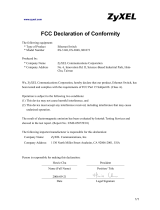
Table of Contents
MGS3750-28F User’s Guide
5
6.1.2 VLAN Port Settings ..................................................................................................................23
6.1.3 Static VLAN .............................................................................................................................24
6.2 Static Mac Forwarding .......................................................................................................................25
6.3 Spanning Tree Protocol .....................................................................................................................27
6.3.1 Spanning Tree Configuration ...................................................................................................28
6.3.2 Compatible/Rapid Spanning Tree Protocol ..............................................................................29
6.3.3 Multiple Spanning Tree Protocol ..............................................................................................31
6.4 ERPS Protocol ..................................................................................................................................33
6.4.1 Instance Screen .......................................................................................................................34
6.5 EAPS Protocol ..................................................................................................................................34
6.6 Layer 2 Protocol Tunnel ....................................................................................................................37
6.7 Bandwidth Control .............................................................................................................................38
6.8 Broadcast Storm Control ...................................................................................................................39
6.9 Mirroring ............................................................................................................................................40
6.10 Link Aggregation .............................................................................................................................41
6.10.1 Link Aggregation Setting .......................................................................................................42
6.10.2 Link Aggregation Control Protocol .........................................................................................44
6.10.3 Group ID ................................................................................................................................44
6.10.4 Port ........................................................................................................................................45
6.11 Port Security ....................................................................................................................................45
6.12 Classifier .........................................................................................................................................47
6.13 Policy Rule ......................................................................................................................................50
6.14 Queuing Method ..............................................................................................................................52
6.15 Multicast ..........................................................................................................................................53
6.15.1 Multicast Setting ....................................................................................................................54
6.15.2 IGMP Snooping Deny VLAN .................................................................................................55
6.15.3 IGMP Filtering Profile ............................................................................................................56
6.16 CPU Queue Control ........................................................................................................................57
6.17 DoS Attack Control ..........................................................................................................................58
Chapter 7
Management........................................................................................................................................61
7.1 Maintenance ......................................................................................................................................61
7.1.1 Firmware Upgrade ...................................................................................................................61
7.1.2 Restart System ........................................................................................................................62
7.1.3 OAM Diag ................................................................................................................................63
7.2 Access Control ..................................................................................................................................63
7.2.1 SNMP ......................................................................................................................................64
7.2.2 User Information ......................................................................................................................65
7.2.3 Logins ......................................................................................................................................67
7.3 Diagnostic .........................................................................................................................................68
7.4 Syslog Setup .....................................................................................................................................68
7.4.1 Syslog Server Setup ................................................................................................................69




















